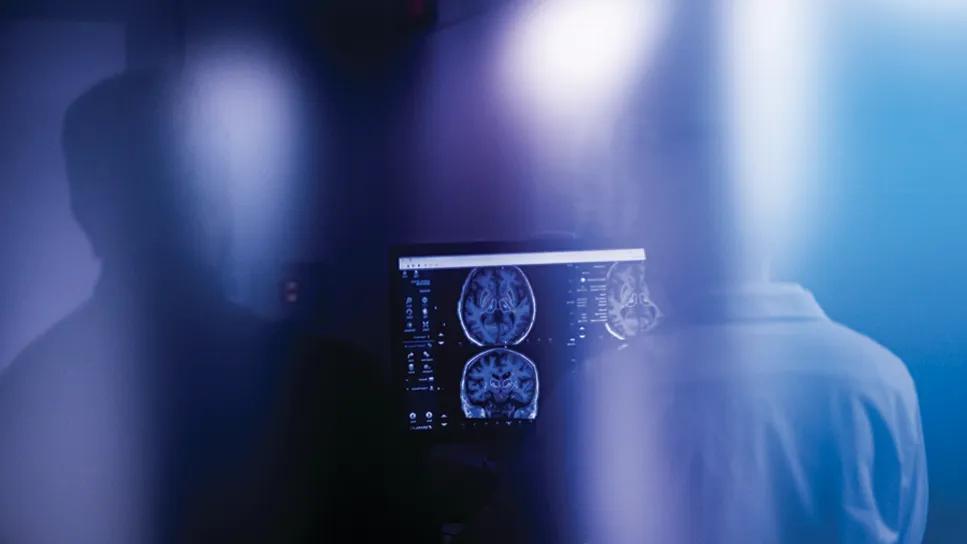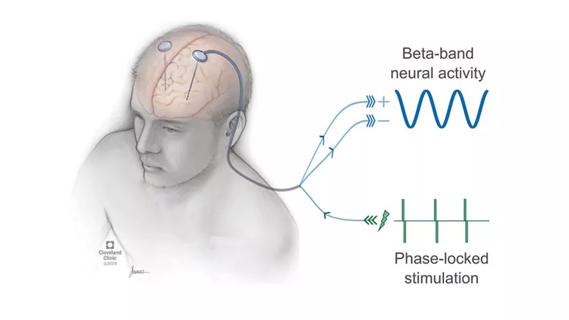Early assessment could affect clinical decision making

Cleveland Clinic researchers applying machine learning to brain MRI data have identified two distinct groups of people with early Parkinson’s disease (PD) whose cognitive and motor-health trajectories took starkly different paths. The team’s novel approach holds potential for early identification of patients at higher risk for cognitive decline and Parkinson-related dementia.
Advertisement
Cleveland Clinic is a non-profit academic medical center. Advertising on our site helps support our mission. We do not endorse non-Cleveland Clinic products or services. Policy
The research at Cleveland Clinic’s Center for Neurological Restoration was published recently in the Journal of the Neurological Sciences. It builds upon other data-driven approaches for subtyping Parkinson’s patients by addressing the “curse of dimensionality,” a data-analysis phenomenon in which a high number of features in a given study makes distilling relevant information difficult. Reducing the analysis to six composite scores from six brain regions was essential for accomplishing that.
The two groups’ cognitive and motor-symptom changes were then compared over 48 months. Subtype 1, whose initial MRIs showed frontal and subcortical atrophy, experienced greater cognitive decline and faster progression of gait and stability symptoms. The results demonstrate that neuroanatomical variations drive differences in clinical manifestations over time.
While Parkinson’s is considered primarily a movement disorder, about a third of patients are experiencing mild cognitive decline at the time of diagnosis, and half of patients will develop PD-related dementia within 10 years of diagnosis. The ability to predict who is at higher risk may have implications for disease management and treatment targeting.
“Traditionally, PD patients have been classified based on clinical assessment tools,” says Anupa A. Vijayakumari, PhD, a data scientist and machine-learning researcher at Cleveland Clinic’s Center for Neurological Restoration. “These approaches do not account for underlying neurobiological mechanisms of disease. We needed a classification framework that delineates heterogeneous PD patients based on neurobiological data such as MRI to be more effective.”
Advertisement
Neurologist Benjamin Walter, MD, MBA, points out that PD-related cognitive impairment differs from what people typically think of as it relates to Alzheimer’s disease.
“Some people with Parkinson's have no cognitive decline. Some people have mild cognitive impairment, and some people have dementia,” says Dr. Walter. “The pattern is more subcortical, and with that they typically have more executive dysfunction. They may have difficulty with planning or organizing their thoughts, where in a condition like Alzheimer's, it’s more likely to be pure short-term memory loss.”
With more extensive cognitive decline, people with Parkinson's are also prone to hallucinations, he adds. Understanding a patient’s propensity for developing more serious cognitive symptoms, then, may have an impact on clinical decision making.
“There may be a need for carefully balancing their medications,” says Dr. Walter. “It might affect the types of medications that we use to treat their motor symptoms so we can avoid or mitigate hallucinations or psychosis.”
To identify Parkinson’s subtypes based on patterns of gray matter atrophy, the researchers analyzed T1-weighted MRI data, cognitive scores and motor scores from 114 newly diagnosed patients and 120 healthy individuals. (Participants were obtained from the Parkinson’s Progression Markers Initiative public database.) In the subsequent cognitive and motor assessments, the two subtypes showed no differences at baseline but diverged in a statistically meaningful way over the years.
Advertisement
The group’s novel approach was to use multivariate gray matter volumetric distances (MGMV), which effectively reduced the number of brain regions while identifying robust PD subtypes.

“We needed to make progress in delineating PD subtypes based on high dimensional MRI data,” she says. “We thought that it was crucial to implement methodological advancements that could reduce the number of MRI features. And we developed a method which aimed to enhance cluster accuracy and to identify more clinically meaningful subtypes.”
It is important to note that at the 48-month follow-up, all the PD patients were on dopaminergic medication, with no differences in medication levels between the two subtypes, says Dr. Vijayakumari. “That tells us that the differences in cognitive decline in these two subtypes were not due to medication effects, but because of underlying anatomical changes that were already present in their brains in the early stages of PD.”
The research helps address a challenge that is different in assessing Parkinson’s-related cognitive decline compared to Alzheimer’s.
“Quantitative MRI can measure the size of the hippocampus, and that can be predictive of Alzheimer's disease,” says Dr. Walter. “But we don't expect those changes to be significant in people with Parkinson's-related cognitive decline or dementia. Parkinson’s-related changes are more subtle, and involve other areas. This statistical model is able to detect some of those changes.”
Dr. Vijayakumari notes that “none of our patients showed any signs of cognitive impairment in the early stages of disease. The selective atrophy patterns that we observed in Subtype 1 patients may serve as an early anatomical markers for patients who will experience more cognitive decline. Another interesting thing was that not all patients follow the same cognitive trajectory. Some remain stable longer while others decline rapidly due to their atrophies.”
Further research should include longer follow-up.
“Our study tracked patients only for 48 months,” Dr. Vijayakumari says. “It is unknown if and when Subtype 2 patients will develop cognitive deficits. And we also haven’t investigated gray matter atrophy changes over time. Investigating that would help us determine whether the structural patterns eventually extend to other brain areas or not. We also believe that we need to include other imaging modalities, like functional MRI or white-matter imaging techniques, to get a deeper understanding into the structural and functional changes in these subtypes.”
The study also suggests the potential for gleaning more information for PD patients as a matter of course, says Dr. Walter.
“Everybody typically gets an MRI early in the diagnosis with Parkinson's disease to rule out other structural changes to see the health of their brain,” he says. “There's a lot of rich information in that image of the brain, and we only get a little bit out of that with the existing ways of analyzing it. But this may be able to extract more information that may be useful over time.”
Advertisement
Advertisement

Various AR approaches affect symptom frequency and duration differently

Dopamine agonist performs in patients with early stage and advanced disease

Systems genetics approach sets stage for lab testing of simvastatin and other candidate drugs

Study aims to inform an enhanced approach to exercise as medicine

New tool for general neurologists aims to streamline differential diagnosis

Patient history plays a key role in identifying the condition

When and how a multidisciplinary palliative care clinic can fill unmet needs for this population

Research project will leverage insights into neural circuits to advance DBS technology